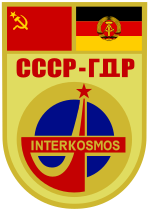Soyuz 31
| Mission emblem | |||||||
|---|---|---|---|---|---|---|---|

|
|||||||
| Mission dates | |||||||
| Mission: | Soyuz 31 | ||||||
| COSPAR-ID : | 1978-81 | ||||||
| Spacecraft: |
Soyuz 7K-T ( GRAY index 11F615A8) serial number 47 |
||||||
| Dimensions: | 6800 kg | ||||||
| Launcher: | Soyuz U (GRAY index 11A511U) | ||||||
| Call sign: | Outward flight: Ястреб (Jastreb - " Habicht ") Return flight: Фотон (" Photon ") |
||||||
| Begin: | August 26, 1978, 14:51:30 UTC | ||||||
| Starting place: | Baikonur 1/5 | ||||||
| Space station: | Salyut 6 | ||||||
| Coupling: | August 28, 1978, 16:37:37 UTC | ||||||
| Decoupling: | November 2, 1978, 07:46 UTC | ||||||
| Landing: | November 2, 1978, 11:04:17 UTC | ||||||
| Landing place: | 180 km southwest of Djeskazgan | ||||||
| Flight duration: | 67d 20h 12m 47s | ||||||
| Earth orbits: | 1069 | ||||||
| Rotation time : | 88.8 min | ||||||
| Apogee : | 260 km | ||||||
| Perigee : | 197 km | ||||||
| Team photo | |||||||
 Valery Bykowski and Sigmund Jähn |
|||||||
| ◄ Before / After ► | |||||||
|
|||||||
Soyuz 31 is the mission name for the flight of a Soviet Soyuz spacecraft to the Soviet space station Salyut 6, which started on August 26, 1978 . It was the sixth visit by a Soyuz spacecraft to this space station and the 50th flight in the Soyuz program. Sigmund Jähn was the first German to fly into space as part of the Interkosmos space program . The spacecraft was brought to the space station by the fourth visiting crew Salyut 6 EP-4 and served the second long-term crew Salyut 6 EO-2 to return.
crew
Starting crew
- Valery Fyodorovich Bykowski (3rd space flight), commander
-
Sigmund Jähn (1st space flight), research cosmonaut ( GDR )

After Schatalow (1971), Jelissejew (1971) and Klimuk (1978), Bykowski was the fourth cosmonaut to make three space flights. This flight was also the last to use a veteran of the Vostok program.
Substitute team
- Viktor Wassiljewitsch Gorbatko , commandant
-
Eberhard Köllner , research cosmonaut ( GDR )

Return crew, launched on Soyuz 29
- Wladimir Wassiljewitsch Kowaljonok (2nd space flight), commander
- Alexander Sergejewitsch Ivantschenkow (1st space flight), flight engineer
Mission overview
After Bykowski and Jähn docked with the Salyut 6 space station on August 28, 1978, they were greeted there by the regular crew of Kowaljonok and Ivanchenkov. Numerous scientific experiments were carried out over the next seven days. These included scientific and technical experiments with the MKF 6 multispectral camera for remote sensing of the earth, material science experiments, experiments on crystallization , shape cultivation and recrystallization as well as cultivation of a monocrystalline , medical experiments, investigation of the effects of weightlessness on speech, work psychological investigations, examination of the hearing threshold of the regular crew, biological experiments on cell growth in weightlessness and on the connection of microorganisms with organic polymers and inorganic substances.
After the departure of Bykowski and Jähn on September 3, Soyuz 31 remained at the rear coupling connection of the Salyut as a return spacecraft for Kowaljonok and Ivanchenkov. This port was necessary for the expected Transporter Progress 4 , because only from there could the delivered fuel be pumped into the Salyut tanks. So the two cosmonauts went into the spaceship on September 7th, disconnected and set back a few hundred meters. The ground station rotated Salyut 6 half a turn so that the Soyuz spacecraft could dock with the forward port. This was the first time in the history of space travel that a spaceship decoupled from a space station.
On November 2, 1978, Kowaljonok and Ivanchenkov went back to their spaceship and returned to Earth.
See also
- Manned space travel
- Russian space travel
- List of manned missions to the Salyut 6 space station
- List of Salyut 6 expeditions
- List of space exits
- List of spacemen
literature
- Sigmund Jähn: Space Experience , Military Publishing House of the German Democratic Republic , Berlin 1983
Web links
- Soyuz 31 at spacefacts.de
- Soyuz 31 at space.kursknet.ru (English / Russian , archived 2016)
- Soyuz 31 in the Encyclopedia Astronautica (English)
- Soyuz 31 in the NSSDCA Master Catalog (English)





